amplifier
Create two-port amplifier element
Description
Use the amplifier object to create a two-port amplifier
element or to analyze a commercial off-the-shelf (COTS) amplifier. You can also use the
amplifier object to model an amplifier in an RF system created
using an rfbudget object
or the RF Budget Analyzer app and, then export this element to RF
Blockset™ or to rfsystem
System object™ for circuit envelope analysis.
Creation
Properties
Name of amplifier, specified as a character vector. All names must be valid MATLAB® variable names.
Example: Name='amp'
Since R2024b
Amplifier model, specified as one of the following:
'cubic'— Cubic polynomial model. When you set this value, theamplifierobject uses theGain,Zin,Zout, andNFproperties to compute gain, matching, and noise.'sparam'— S-parameter model. When you set this value, theamplifierobject uses theNetworkDataandNoiseDataproperties to compute gain, matching, and noise. Input the S-parameter data using the NetworkData or FileName property.'ampm'— AM/PM-AM/PM model. When you set this value, theamplifierobject uses AM/AM–AM/PM data to characterize the amplifier. Input AM/AM–AM/PM data using the AMPMTable property.
Example: Model='ampm'
Available power gain, specified as a real finite scalar in dB.
Example: Gain=10
Noise figure, specified as a real finite nonnegative scalar dB.
Example: NF=-10
Second-order output-referred intercept point, specified as a real scalar in dBm.
Example: OIP2=8
Third-order output-referred intercept point, specified as a real scalar in dBm.
Example: OIP3=10
Input impedance, specified as a positive real part finite scalar in ohms. You can also use a complex value with a positive real part.
Example: Zin=40
Output impedance, specified as a scalar in ohms. You can also use a complex value with a positive real part.
Example: Zout=40
Name of the two-port Touchstone file from which to extract the
NetworkData and the NoiseData
properties, specified as a string scalar or character vector.
Example: FileName='default.s2p'
Network data of the amplifier, specified as a two-port network parameter object. The network parameter objects are of the type:
Network parameter object defines the frequency-dependent gain and
impedance matching for the amplifier, typically, a
sparameters object from a two-port Touchstone file. To
specify a frequency-independent network data, set the
NetworkData property to []. This
resets network data to a frequency-independent two-port network object
defined by the Gain, Zin, and
Zout properties.
Example: NetworkData=nd
Noise data of the amplifier, specified as a noiseParameters object. The noiseParameter
object contains a frequency-dependent noise figure loaded from a two-port
Touchstone file or built at the MATLAB® command line. To specify a
frequency-independent noise figure, set the NoiseData
to [].
Example: NoiseData=np
Since R2023b
Lookup table entries, specified as a real M-by-3 matrix. M must be a positive scalar. The first column of the matrix represents the input power, and the values in this column must increase monotonically. The second column of the matrix represents the output power in dBm in the AM/AM-AM/PM model and the third column represents the phase change in degrees in the model. The values in the second and third columns are related to the absolute value of the power of the input signal represented in the first column.
To enable the AMPMTable property, set
Model to ampm.
Example: AMPMTable=[ -25, 5, 0; -10, 20, -2; 0, 27, 5; 5, 28, 12
]
This property is read-only.
Number of ports, returned as a scalar integer.
This property is read-only.
Names of port terminals, returned as a cell vector.
Object Functions
Examples
Use the RF Toolbox amplifier object to model a Qorvo CMD240 COTS amplifier. First, use the sparameter object to capture the S-parameter data from the CMD240 data file (Copyright (c) Qorvo, Inc., reproduced with permission).
S = sparameters('cmd240-sparameters.s2p');
rfplot(S)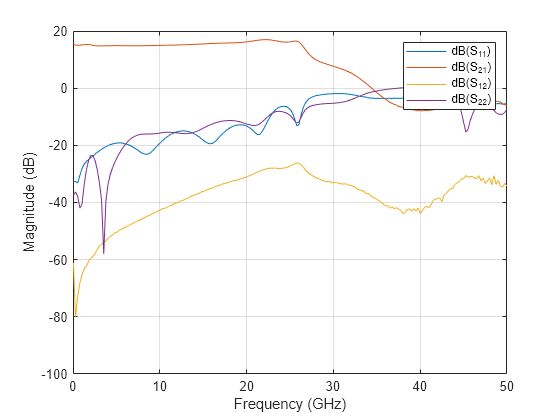
Then use the noiseParameters object to build the noise data.
NF = [4 2.9 2.2 1.8 2.2 2 2.1 2.3 2.4 3.1 3.7]; freqs = (2:2:22)*1e9; nd = noiseParameters(NF,freqs,50)
nd =
noiseParameters with properties:
Frequencies: [11×1 double]
Fmin: [11×1 double]
GammaOpt: [11×1 double]
Rn: [11×1 double]
Create an amplifier using the CMD240 data file and add the noise data to the amplifier.
a1 = amplifier('FileName','cmd240-sparameters.s2p','OIP3',27.8); a1.NoiseData = nd % clears FileName since there is no noise in the file.
a1 =
amplifier: Amplifier element
Name: 'Amplifier'
Model: 'sparam'
FileName: ''
NetworkData: [1×1 sparameters]
NoiseData: [1×1 noiseParameters]
OIP2: Inf
OIP3: 27.8000
Alternatively, you can use the nport object to hold both the S-parameter and the noise data and then use the rfwrite function to create a Touchstone file.
n = nport(NetworkData=S,NoiseData=nd); rfwrite(n,'CMD240withNF.s2p','Format','RI') a = amplifier('FileName','CMD240withNF.s2p','OIP3',27.8);
Use the rfbudget object to compare harmonic balance analysis with Friis analysis.
b = rfbudget(a,10e9,-30,1e3,'Solver','HarmonicBalance'); b.Friis
ans = struct with fields:
OutputPower: -15.0349
TransducerGain: 14.9651
NF: 2.2000
IIP2: []
OIP2: []
IIP3: 12.7828
OIP3: 27.8000
SNR: 111.7752
b.HarmonicBalance
ans = struct with fields:
OutputPower: -15.0353
TransducerGain: 14.9647
NF: 2.1995
IIP2: Inf
OIP2: Inf
IIP3: 12.7825
OIP3: 27.7990
SNR: 111.7756
OneToneSolutions: {[1×1 rf.internal.rfengine.analyses.solution]}
TwoToneSolutions: {[1×1 rf.internal.rfengine.analyses.solution]}
Gain is about 15 dB and noise figure is about 2.2 dB. This matches the product data sheet. For more information, see CMD240 product data sheet. You can verify this in RF Budget Analyzer app.
show(b)
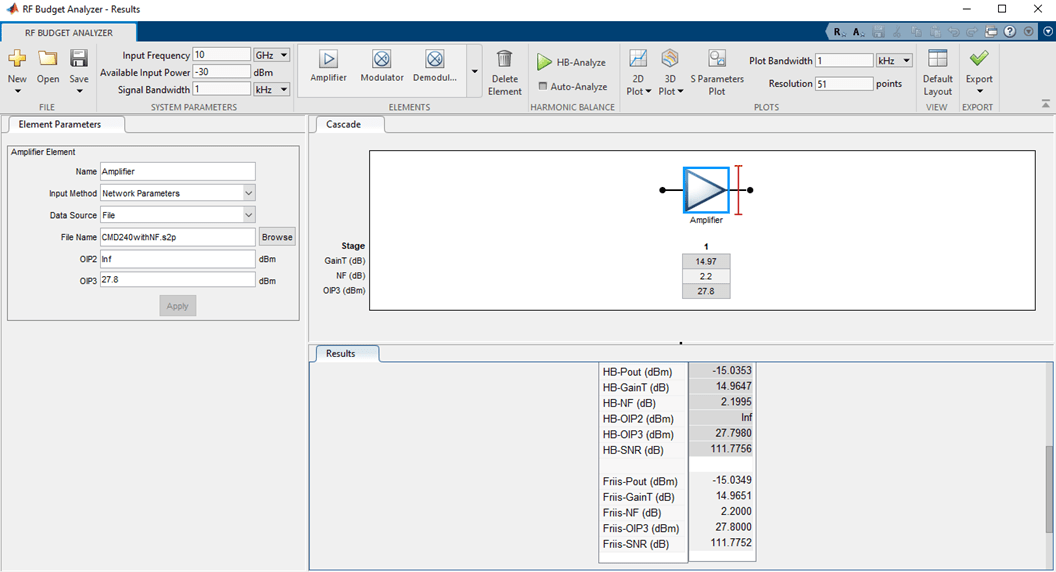
You can also use the exportTestbench function to verify with RF Blockset simulation. Type exportTestbench(b) command at the command line to open measurement testbench from RF budget object.
exportTestbench(b)
Click Run to see the Gain is about 15 dB.
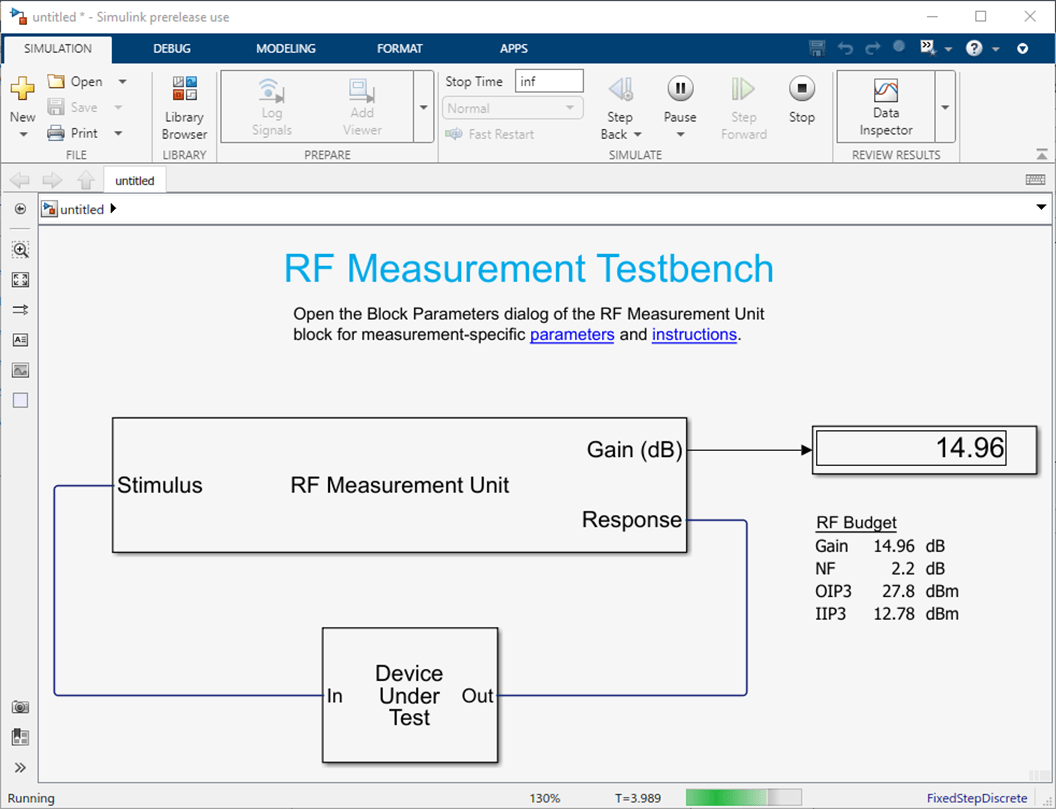
Set the Measured quantity of the RF Measurement Unit to NF and then click Run to see the noise figure is about 2.2 dB.

The amplifier response is displayed in the Spectrum Analyzer window.

Since R2023a
Create an amplifier object.
amp = amplifier;
Plot the amplifier power characteristics at 2.1 GHz.
rfplot(amp,2.1e9)
Set OIP3 of amplifier to 25 dBm.
amp.OIP3 = 25;
Plot the amplifier power characteristics at 2.1 GHz with nonlinearity.
rfplot(amp,2.1e9)
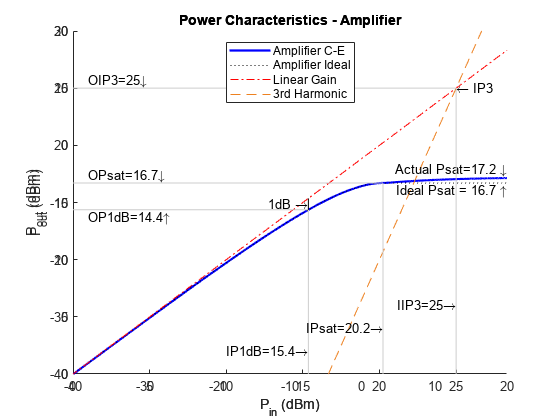
Plot the amplifier power characteristics on the axes specified in ax instead of the current axes.
f = figure; ax = axes(f); rfplot(ax,amp,2.1e9)
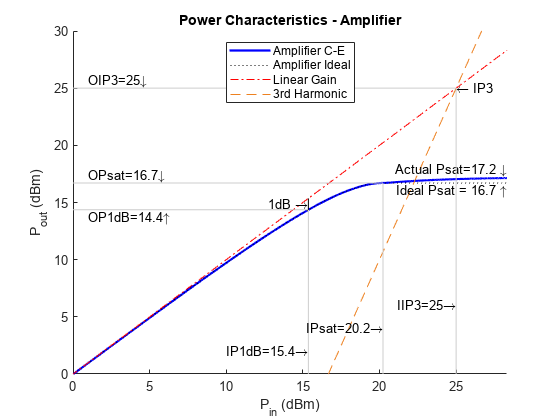
Create an amplifier from the default.s2p Touchstone file.
a = amplifier(FileName='default.s2p')a =
amplifier: Amplifier element
Name: 'Amplifier'
Model: 'sparam'
FileName: 'default.s2p'
NetworkData: [1×1 sparameters]
NoiseData: [1×1 noiseParameters]
OIP2: Inf
OIP3: Inf
Define a measured noise figure, noise frequencies, and the reference impedance data.
NF = [4 3 2 2 2 2 2 2.5 2.5 3 3.5]; freqs = (2:2:22)*1e9; z0 = 50;
Build the noise parameters from the measured NF data.
np = noiseParameters(NF,freqs,z0);
Add this noise data to the amplifier object.
a = amplifier(FileName='default.s2p',NoiseData=np)a =
amplifier: Amplifier element
Name: 'Amplifier'
Model: 'sparam'
FileName: ''
NetworkData: [1×1 sparameters]
NoiseData: [1×1 noiseParameters]
OIP2: Inf
OIP3: Inf
Create an amplifier object named 'LNA' and has a gain of 10 dB.
a = amplifier(Name='LNA',Gain=10)a =
amplifier: Amplifier element
Name: 'LNA'
Model: 'cubic'
Gain: 10
NF: 0
OIP2: Inf
OIP3: Inf
Zin: 50
Zout: 50
Create an amplifier object with a gain of 4 dB. Create another amplifier object that has an output third-order intercept (OIP3) 13 dBm.
amp1 = amplifier('Gain',4); amp2 = amplifier('OIP3',13);
Build a 2-port circuit using the amplifiers.
c = circuit([amp1 amp2])
c =
circuit: Circuit element
ElementNames: {'Amplifier' 'Amplifier_1'}
Elements: [1×2 amplifier]
Nodes: [0 1 2 3]
Name: 'unnamed'
Create an amplifier with a gain of 4 dB.
a = amplifier(Gain=4);
Create a modulator with an OIP3 of 13 dBm.
m = modulator(OIP3=13);
Create an N-port element using passive.s2p.
n = nport('passive.s2p');Create an RF element with a gain of 10 dB.
r = rfelement(Gain=10);
Calculate the RF budget of a series of RF elements at an input frequency of 2.1 GHz, an available input power of –30 dBm, and a bandwidth of 10 MHz.
b = rfbudget([a m r n],2.1e9,-30,10e6)
b =
rfbudget with properties:
Elements: [1x4 rf.internal.rfbudget.Element]
InputFrequency: 2.1 GHz
AvailableInputPower: -30 dBm
SignalBandwidth: 10 MHz
Solver: Friis
AutoUpdate: true
Analysis Results
OutputFrequency: (GHz) [ 2.1 3.1 3.1 3.1]
OutputPower: (dBm) [ -26 -26 -16 -20.6]
TransducerGain: (dB) [ 4 4 14 9.4]
NF: (dB) [ 0 0 0 0.1392]
IIP2: (dBm) []
OIP2: (dBm) []
IIP3: (dBm) [ Inf 9 9 9]
OIP3: (dBm) [ Inf 13 23 18.4]
SNR: (dB) [73.98 73.98 73.98 73.84]
Type the show command at the command window to display the analysis in the RF Budget Analyzer app.
show(b)
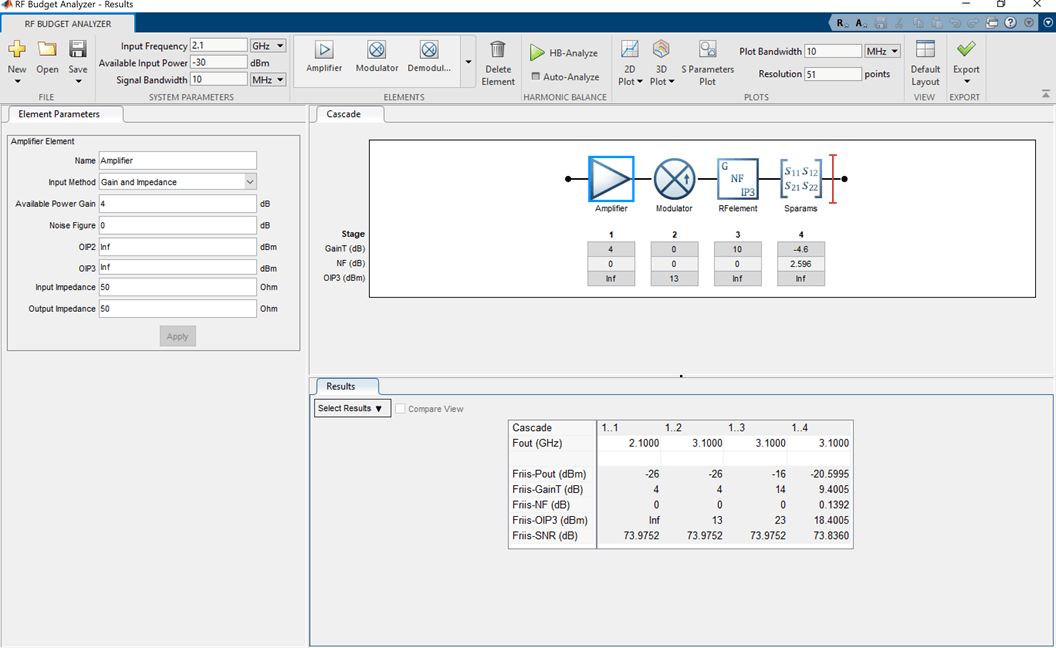
Version History
Introduced in R2017aUse the new Model property in the amplifier
object to design an amplifier using the cubic polynomial model, AM/AM-AM/PM data, or
S-parameter data.
The UseNetworkData and UseAMPMData
properties of the amplifier object will be removed in a future
release. Use the new Model property instead.
When executing code with the amplifier object that uses the
UseNetworkData and UseAMPMData
properties, the software will replace these properties with the new
Model property. The software assigns the
Model property an sparam value if the
original property is UseNetworkData and
anampm value if the original property is
UseAMPMData.
amplifier is recommended over rfckt.amplifer,
rfdata.ip3, rfdata.powerand
rfdata.nf because it enables you to:
Create a two-port amplifier element.
Analyze a commercial off-the-shelf (COTS) amplifier.
Specify third-order intercept points and noise figure.
Characterize amplifiers using AM/AM-AM/PM data.
Build a
circuitobject with an amplifier element.Model an amplifier in an RF chain created using an
rfbudgetobject or the RF Budget Analyzer app, and then export this element to RF Blockset or torfsystemSystem object for circuit envelope analysis.
To model an RF amplifier element using network parameters from a two-port Touchstone file, specify the name of the file in the FileName property. The object extracts the values of the NetworkData and the NoiseData properties from this file.
See Also
modulator | nport | circuit | noiseParameters | add
MATLAB Command
You clicked a link that corresponds to this MATLAB command:
Run the command by entering it in the MATLAB Command Window. Web browsers do not support MATLAB commands.
选择网站
选择网站以获取翻译的可用内容,以及查看当地活动和优惠。根据您的位置,我们建议您选择:。
您也可以从以下列表中选择网站:
如何获得最佳网站性能
选择中国网站(中文或英文)以获得最佳网站性能。其他 MathWorks 国家/地区网站并未针对您所在位置的访问进行优化。
美洲
- América Latina (Español)
- Canada (English)
- United States (English)
欧洲
- Belgium (English)
- Denmark (English)
- Deutschland (Deutsch)
- España (Español)
- Finland (English)
- France (Français)
- Ireland (English)
- Italia (Italiano)
- Luxembourg (English)
- Netherlands (English)
- Norway (English)
- Österreich (Deutsch)
- Portugal (English)
- Sweden (English)
- Switzerland
- United Kingdom (English)